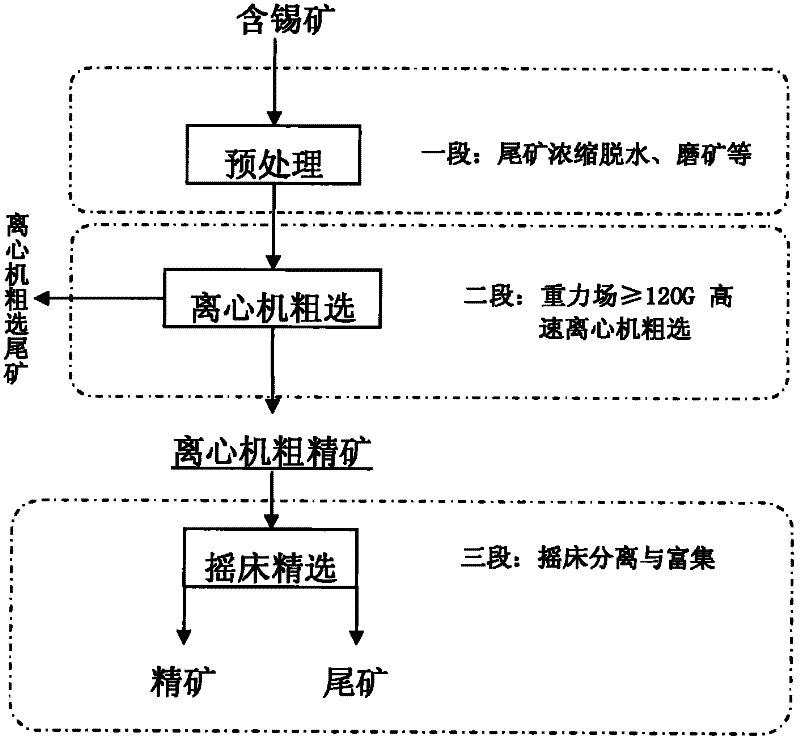Method for recovering tin by centrifugal concentration
A centrifugal concentrator and concentrator technology, applied in chemical instruments and methods, solid separation, wet separation, etc., can solve the problems of large investment and land occupation, difficulty in effective recovery, low tin recovery rate, etc., to achieve load reduction, Less environmental pollution and improved beneficiation efficiency
- Summary
- Abstract
- Description
- Claims
- Application Information
AI Technical Summary
Problems solved by technology
Method used
Image
Examples
Embodiment 1
[0030] The ore processed by a concentrator is copper, zinc and tin-containing polymetallic associated ore. After the ore is crushed, ore-ground, and flotation to extract copper and zinc, the tailings enter the tin beneficiation operation. The processing capacity of tin selection operation is 100t / h (continuous flow), tin SnO 2 The grade is 0.4%, and the concentration is 16.8%.
[0031] The tin ore is recovered by adopting the method of recovering tin shown in the accompanying drawing, and the pulp is first transported to a cyclone for dehydration treatment, so that the water content of the pulp is 20-35%; the dehydrated pulp is further subjected to ball milling to control the The ore fineness is -200 mesh, accounting for 80%. The pulp after ball milling is introduced into a high-speed centrifuge for gravity beneficiation. The high-speed centrifuge uses a Falcon centrifugal concentrator with a gravity field of 140G. One-time sweeping process, roughing and sweeping concentrates...
Embodiment 2
[0034] The processing capacity of a tin ore dressing plant is 150t / h (continuous flow): tin SnO 2 The grade is 0.8-1.0%, and the concentration is 20%.
[0035] The tin ore is recovered by using the tin recovery method shown in the accompanying drawing. Since the tin ore has a water content of 20% after crushing, grinding and grading, no further concentration and dehydration is needed, and other indicators such as particle size can reach the centrifuge Gravity separation requirements, the tin ore slurry is directly introduced into the centrifuge for gravity beneficiation. The centrifugal beneficiation machine adopts a Nelson centrifugal concentrator with a gravity field of 180G. The tailings after gravity separation are directly discharged to the tailings pond; the coarse concentrate obtained by centrifugal gravity separation has a relatively large particle size. In order to improve the efficiency of shaker separation, the coarse concentrate is subjected to grinding treatment t...
Embodiment 3
[0038] A tin-bearing mineral processing plant processes tin-containing old tailings. The processing capacity of the processing plant is 50t / h (continuous flow). The tailings contain 0.19% tin grade, coarse particle size, and conjoined organisms account for the majority.
[0039] The method of recovering tin shown in the attached figure is used to re-select the old tailings of tin-containing ore dressing, and the tailings are transported from the tailings pond to the ore processing plant, and firstly undergo ball milling treatment to control the grinding fineness to -200 mesh. 80%, the tailings after ball milling are introduced into the centrifuge for gravity beneficiation. The final tailings are directly discharged to the tailings dam, and the coarse concentrate enters the classification shaking table for selection. The classification adopts the sequential combination of hydrocyclone and fine screen, and the coarse concentrate is divided into 200 mesh and 100 mesh as the classi...
PUM
 Login to View More
Login to View More Abstract
Description
Claims
Application Information
 Login to View More
Login to View More - R&D
- Intellectual Property
- Life Sciences
- Materials
- Tech Scout
- Unparalleled Data Quality
- Higher Quality Content
- 60% Fewer Hallucinations
Browse by: Latest US Patents, China's latest patents, Technical Efficacy Thesaurus, Application Domain, Technology Topic, Popular Technical Reports.
© 2025 PatSnap. All rights reserved.Legal|Privacy policy|Modern Slavery Act Transparency Statement|Sitemap|About US| Contact US: help@patsnap.com

